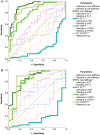Changes in Hepatic Venous Pressure Gradient Predict Hepatic Decompensation in Patients Who Achieved Sustained Virologic Response to Interferon-Free Therapy
- PMID: 31365764
- PMCID: PMC7155089
- DOI: 10.1002/hep.30885
Changes in Hepatic Venous Pressure Gradient Predict Hepatic Decompensation in Patients Who Achieved Sustained Virologic Response to Interferon-Free Therapy
Abstract
Background and aims: Sustained virologic response (SVR) to interferon (IFN)-free therapies ameliorates portal hypertension (PH); however, it remains unclear whether a decrease in hepatic venous pressure gradient (HVPG) after cure of hepatitis C translates into a clinical benefit. We assessed the impact of pretreatment HVPG, changes in HVPG, and posttreatment HVPG on the development of hepatic decompensation in patients with PH who achieved SVR to IFN-free therapy. Moreover, we evaluated transient elastography (TE) and von Willebrand factor to platelet count ratio (VITRO) as noninvasive methods for monitoring the evolution of PH.
Approach and results: The study comprised 90 patients with HVPG ≥ 6 mm Hg who underwent paired HVPG, TE, and VITRO assessments before (baseline [BL]) and after (follow-up [FU]) IFN-free therapy. FU HVPG but not BL HVPG predicted hepatic decompensation (per mm Hg, hazard ratio, 1.18; 95% confidence interval, 1.08-1.28; P < 0.001). Patients with BL HVPG ≤ 9 mm Hg or patients who resolved clinically significant PH (CSPH) were protected from hepatic decompensation. In patients with CSPH, an HVPG decrease ≥ 10% was similarly protective (36 months, 2.5% vs. 40.5%; P < 0.001) but was observed in a substantially higher proportion of patients (60% vs. 24%; P < 0.001). Importantly, the performance of noninvasive methods such as TE/VITRO for diagnosing an HVPG reduction ≥ 10% was inadequate for clinical use (area under the receiver operating characteristic curve [AUROC], < 0.8), emphasizing the need for HVPG measurements. However, TE/VITRO were able to rule in or rule out FU CSPH (AUROC, 0.86-0.92) in most patients, especially if assessed in a sequential manner.
Conclusions: Reassessment of HVPG after SVR improved prognostication in patients with pretreatment CSPH. An "immediate" HVPG decrease ≥ 10% was observed in the majority of these patients and was associated with a clinical benefit, as it prevented hepatic decompensation. These results support the use of HVPG as a surrogate endpoint for interventions that lower portal pressure by decreasing intrahepatic resistance.
© 2019 The Authors. Hepatology published by Wiley Periodicals, Inc., on behalf of American Association for the Study of Liver Diseases.
Figures




Similar articles
-
Noninvasive Risk Stratification After HCV Eradication in Patients With Advanced Chronic Liver Disease.Hepatology. 2021 Apr;73(4):1275-1289. doi: 10.1002/hep.31462. Epub 2021 Mar 16. Hepatology. 2021. PMID: 32659847 Free PMC article.
-
Sustained virologic response to interferon-free therapies ameliorates HCV-induced portal hypertension.J Hepatol. 2016 Oct;65(4):692-699. doi: 10.1016/j.jhep.2016.05.027. Epub 2016 May 27. J Hepatol. 2016. PMID: 27242316
-
Effects of All-Oral Anti-Viral Therapy on HVPG and Systemic Hemodynamics in Patients With Hepatitis C Virus-Associated Cirrhosis.Gastroenterology. 2017 Nov;153(5):1273-1283.e1. doi: 10.1053/j.gastro.2017.07.016. Epub 2017 Jul 20. Gastroenterology. 2017. PMID: 28734831
-
Are there any alternative methods to hepatic venous pressure gradient in portal hypertension assessment?J Gastrointestin Liver Dis. 2013 Mar;22(1):73-8. J Gastrointestin Liver Dis. 2013. PMID: 23539394 Review.
-
Hepatic Venous Pressure Gradient: Measurement and Pitfalls.Clin Liver Dis. 2024 Aug;28(3):383-400. doi: 10.1016/j.cld.2024.03.009. Epub 2024 May 1. Clin Liver Dis. 2024. PMID: 38945633 Review.
Cited by
-
Evolution of spontaneous portosystemic shunts over time and following aetiological intervention in patients with cirrhosis.JHEP Rep. 2023 Nov 30;6(2):100977. doi: 10.1016/j.jhepr.2023.100977. eCollection 2024 Feb. JHEP Rep. 2023. PMID: 38283756 Free PMC article.
-
Plasma IP-10 and IL-6 are linked to Child-Pugh B cirrhosis in patients with advanced HCV-related cirrhosis: a cross-sectional study.Sci Rep. 2020 Jun 25;10(1):10384. doi: 10.1038/s41598-020-67159-3. Sci Rep. 2020. PMID: 32587340 Free PMC article.
-
Liver Fibrosis Regression and Associated Factors in HCV Patients Treated with Direct-Acting Antiviral Agents.Life (Basel). 2023 Sep 5;13(9):1872. doi: 10.3390/life13091872. Life (Basel). 2023. PMID: 37763276 Free PMC article.
-
Noninvasive Risk Stratification After HCV Eradication in Patients With Advanced Chronic Liver Disease.Hepatology. 2021 Apr;73(4):1275-1289. doi: 10.1002/hep.31462. Epub 2021 Mar 16. Hepatology. 2021. PMID: 32659847 Free PMC article.
-
Characteristics of hepatocellular carcinoma in patients with hepatitis C virus who received direct-acting antiviral therapy and achieved sustained virological response: The impact of a hepatologist on surveillance.JGH Open. 2022 Jun 6;6(7):462-469. doi: 10.1002/jgh3.12774. eCollection 2022 Jul. JGH Open. 2022. PMID: 35822120 Free PMC article.
References
-
- Mandorfer M, Schwabl P, Steiner S, Scheiner B, Chromy D, Bucsics T, et al. Interferon‐free treatment with sofosbuvir/daclatasvir achieves sustained virologic response in 100% of HIV/hepatitis C virus‐coinfected patients with advanced liver disease. AIDS 2016;30:1039‐1047. - PubMed
-
- Mandorfer M, Schwabl P, Steiner S, Reiberger T, Peck‐Radosavljevic M. Advances in the management of HIV/HCV coinfection. Hepatol Int 2016;10:424‐435. - PubMed
-
- Mandorfer M, Kozbial K, Freissmuth C, Schwabl P, Stattermayer AF, Reiberger T, et al. Interferon‐free regimens for chronic hepatitis C overcome the effects of portal hypertension on virological responses. Aliment Pharmacol Ther 2015;42:707‐718. - PubMed
-
- Ferenci P, Kozbial K, Mandorfer M, Hofer H. HCV targeting of patients with cirrhosis. J Hepatol 2015;63:1015‐1022. - PubMed
-
- Jacobson IM, Lim JK, Fried MW. American Gastroenterological Association Institute Clinical Practice Update‐Expert Review: care of patients who have achieved a sustained virologic response after antiviral therapy for chronic hepatitis C infection. Gastroenterology 2017;152:1578‐1587. - PubMed
Publication types
MeSH terms
Substances
LinkOut - more resources
Full Text Sources
Other Literature Sources

